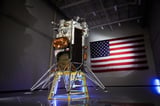NASA Seeks Industry Innovations for Boosted Lunar Cargo Delivery in Artemis Missions
October 8, 2024
NASA's recent white paper on Lunar Surface Cargo highlights the critical need for enhanced cargo delivery capabilities to support future lunar missions.
In September, NASA issued a request for proposals aimed at addressing lunar mobility deficiencies and improving logistics for its upcoming missions.
This request seeks innovative solutions from U.S. industry for lunar logistics and mobility, particularly designs for landers and vehicles to support the Artemis missions.
This initiative is part of NASA's Next Space Technologies for Exploration Partnerships (NextSTEP-2), which promotes the commercial development of deep space exploration capabilities.
Currently, NASA can deliver about 1,500 kilograms of cargo, but future missions may require moving between 4,400 to 13,000 pounds, necessitating larger capacities.
Existing lunar mobility solutions, such as the Lunar Terrain Vehicle and Pressurized Rover, have limitations in cargo capacity, which underscores the need for new capabilities.
The proposed Cargo Lander must ensure safe delivery of cargo, providing essential services like power, communications, and thermal management for effective offloading.
Key logistics items for lunar missions include food, water, air, and spare parts, especially critical for operations at the planned lunar South Pole.
As NASA increases the frequency and duration of lunar missions, the demand for effective logistics will grow significantly, requiring enhanced capabilities.
Transportation of landed cargo from landing sites to operational areas is essential for efficient lunar exploration and mission success.
Nujoud Merancy from NASA emphasized the importance of collaboration with diverse commercial partners to enhance exploration architecture.
Brooke Thornton from NASA's Strategy and Architecture Office highlighted the agency's interest in creative insights from industry to inform logistics and mobility strategies.
Summary based on 5 sources
Get a daily email with more Science stories
Sources

NASA • Oct 8, 2024
NASA Seeks Innovative Artemis Lunar Logistics, Mobility Solutions - NASA
Phys.org • Oct 9, 2024
NASA seeks innovative Artemis lunar logistics, mobility solutions
UPI • Oct 8, 2024
NASA seeks logistics designs for Artemis moon missions - UPI.com
Mirage News • Oct 8, 2024
NASA Eyes New Artemis Lunar Logistics Solutions